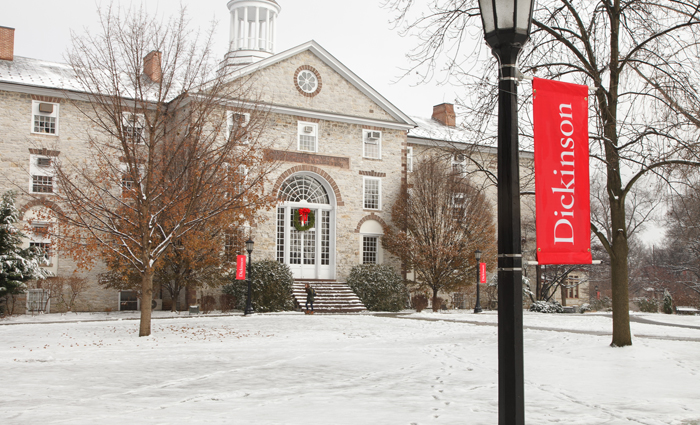Winter 2016 Kudos

Chris Roberts '11 (left), walks with former Secretary of State Madeleine Albright, Professor of International Studies Doug Stuart (right) and Officer Jonathan Mann while on campus for the 2014 Commencement. Photo by Carl Socolow '77.
Publications
Cindy Samet, professor of chemistry, and Yike (Echo) Li ’14, a chemistry and physics double-major who is currently in a graduate program in nanophysics at Northeastern University, published “Polymer Soft-Landing Isolation of Acetylene on Polystyrene and Poly(vinylpyridine): A Novel Approach to Probing Hydrogen Bonding in Polymers” in the Journal of Physical Chemistry B (biophysical chemistry, biomaterials and soft matter). For years the Samet research group has been using the matrix isolation technique—the freezing of molecules in an inert gas at close to absolute zero—to study hydrogen bonding. After their move to the Rector Science Complex, the team pioneered a new technique called Polymer Soft Landing Isolation, which is a twist on the conventional matrix isolation technique. In particular, molecules are now “soft-landed” onto a polymer surface, rather than on a clean surface. This publication represents the second study employing the novel technique, which is unique to Samet’s research at Dickinson.
Brill published Associate Professor of History Jeremy Ball’s Angola’s Colossal Lie: Forced Labor on a Sugar Plantation, 1913-1977. The book is the first in-depth study of forced labor on a Portuguese-owned sugar plantation in colonial Angola. A prominent Portuguese civil servant dubbed the labor system in Angola a “colossal lie” because the reality so contradicted the law. Using extensive oral-history interviews with former forced laborers, Ball explains how Angolans experienced forced labor. Ball also interviews former Portuguese administrators to provide multiple perspectives on the transition to independence and the nationalization of the plantation.
Associate professors of physics and astronomy David Jackson and Brett Pearson and David Mertens, visiting assistant professor of physics, published “Hurricane Balls: A Rigid-Body-Motion Project for Undergraduates” in the American Journal of Physics, a publication of the American Association of Physics Teachers. The article discusses a project for students in an upperdivision course in classical mechanics, in which the authors analyze the motion of hurricane balls, two spheres that are welded (or glued) together so they act as a single object that can be spun like a top.
Professor of Chemistry Amy Witter and Minh Nguyen ’11, a biochemistry & molecular biology and chemistry double major who is Ph.D. candidate in chemistry at the University of Pennsylvania’s School of Arts & Sciences, published “Determination of oxygen, nitrogen, and sulfur-containing polycyclic aromatic hydrocarbons (PAHs) in urban stream sediments” in Environmental Pollution (2015). The article is a follow-up to a 2013 article in the same publication, cowritten by Witter, Nguyen, Sunil Baidar ’09 and Peter Sak, associate professor of earth sciences.
Andrew Wolff, assistant professor of political science and international studies, published “The future of NATO enlargement after the Ukraine crisis” in International Affairs. The article examines the history of NATO-Russian tensions over enlargement, considers how NATO’s enlargement policy factored into the Ukraine crisis and reviews options for the future of enlargement. Drawing on diplomatic history and geopolitical theory, Wolff explains Russia’s persistent hostility toward NATO’s policy of eastward expansion and highlights NATO’s failure to convert Russia to its liberal worldview. Wolff also argues that NATO should alter its current enlargement policy by infusing it with geopolitical rationales and focusing on how candidate countries add to NATO capabilities and impact overall alliance security.
Tara Vasold Fischer ’02, associate dean of advising, college dean and coordinator of the community college partners, reviewed Learn or Die: Using Science to Build a Leading-Edge Learning Organization, by Edward D. Hess, in Phi Beta Kappa’s The Key Reporter. Fischer writes that Learn or Die provides a blueprint for individual and organizational learning and success. Based on the premise that consistent high performance is critically linked to high levels of employee engagement and organizational success, Hess defines factors that cultivate an ability to strategically problem solve, challenging readers to take an active role in shaping the culture around them.
Professor Emeritus of History John Osborne and Christine Bombaro ’93, associate director for research & instructional services published Forgotten Abolitionist: John A.J. Creswell of Maryland under the auspices of Dickinson’s House Divided Project, led by Matthew Pinsker, professor of history, and with support from Dickinson’s Digital Humanities Advisory Committee. The authors explore Creswell’s life, from Southern schoolboy to conservative businessman to noted Republican leader and abolitionist, as well as his identity as a Dickinson valedictorian and, later, trustee. The book is available for download at smashwords.com/books/view/585258.
Browse more faculty publications at scholar.dickinson.edu/faculty_pubs.
Grants & Awards
Associate Professor of Music Amy Wlodarski received a $13,860 research grant from the Paul Sacher Stiftung for her project “Postwar Humanism and the Music of George Rochberg.”
Les Poolman, retired athletic director, was inducted into the West Virginia University College of Physical Activity and Sport Sciences 2015 Hall of Fame and named 2015 Outstanding Alumnus.
Dickinson Magazine garnered an Award of Excellence in the 46th annual design competition held by the University & College Designers Association. The international competition recognizes the best design work to promote educational institutions. The magazine was one of 165 selected from 1,091 entries.
The National Science Foundation awarded $12,000 to Julie Vastine ’03, director of the Alliance for Aquatic Resource Monitoring (ALLARM), for the project “Learning to See, Seeing to Learn: A Sociotechnical System Supporting Taxonomic Identification Activities in Volunteer-Based Water Quality Biomonitoring.” The project is an Innovations in Development proposal to build and study a cyber-enhanced visual learning environment to support observational practices and classification skills in a citizen science context and focuses on the challenge of training volunteers to collect high-quality and reliable data. ALLARM is a partner with the lead institution, Carnegie Mellon University. Vastine also received the 2015 Campus Sustainability Champions award by the Pennsylvania Environmental Resource Consortium during the organization’s fall conference.
Learn More
Read more from the winter 2016 issue of Dickinson Magazine.
Published January 29, 2016